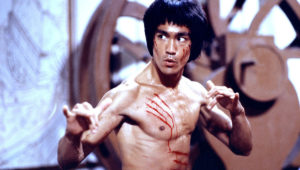Bruce Lee – 47 Years Later and Still No Equal
[AdSense-A]
July 20, 1973 is still a date etched onto the hearts and minds of fighters, fans as well as some of the general public. It’s the day Bruce Lee took a nap after he complained of a headache. He never woke up. At the age of 32, Lee died due to complications linked to cerebral edema, a fatal swelling of the brain presumably brought on by the pain-killing tablet he took to relieve his discomfort.
Long before he graced the movie screen as an action star, Bruce developed a system of fighting known as Jeet Kun Do, also known as “The Way of The Intercepting Fist”. A biographical movie released in 1993, “Bruce Lee – The Dragon Story” told the story of his life, however with a Hollywood twist.
Lee was at one time frowned upon by some in the Asian community in the San Francisco neighborhood in which he lived. In the early 1960’s, he was informed that teaching martial arts to Westerners was forbidden. Although he tried to stress the importance of sharing information, culture and the art of self defense, he was told to halt his actions at once. He refused, so he was forced to face a local fighter with the understanding that if he lost, then he’d immediately close his school.
The street fight took place against a challenger named Wong Jack Man, however the outcome is still subject to debate alongside mythology. In any case, Lee didn’t stop teaching a group of clientele that went on to include such names as James Coburn, Steve McQueen and Kareem Abdul-Jabbar. One thing Bruce claimed to have learned in the bout was that he’d have to train his entire body to its fullest extent if was to continue as a fighter at just about any level.
The aforementioned 1993 movie led many to believe that his battle with Wong was what injured his back by way of a sucker kick once he’d prevailed. That’s a bit more exciting than the truth, which was the damage was actually caused as a result of doing lower back exercises without a proper warmup. In any case, Lee refused to conform to stereotypes attached to Asian characters in TV and film.
When Hollywood wouldn’t bend any further than a few cameo appearances in television programs or short lived serials, he took his talent back to Hong Kong. He appeared in a handful of action pictures such as “The Big Boss”, “Fist of Fury” and “Return of the Dragon”, the last in which he famously fought Chuck Norris in the Coliseum in Rome. Lee finally got the call he’d been waiting for, which was for a full fledged American movie. This was to be the classic known as “Enter the Dragon”. Sadly, he was gone before the movie was released to the public in August of 1973.
Earlier this year, an ESPN documentary, “Be Water” was released to the masses and while it was well crafted and hopefully informative to those who knew of but not much about Lee, there was little within it that was new to the longtime fans of him. I still say the best short storytelling of his life was done sometime in the 1980’s and was released in the United States on CBS Fox Home Video. This was “Bruce Lee: The Legend.”
His influence is undeniable to this day. In terms of boxing, Lee admitted that he admired the footwork of Muhammad Ali and looked to incorporate it into his system of fighting. Of course, a hypothetical matchup is something many people love to discuss. There’s more than a few fighters of all disciplines who confess that Bruce Lee would knock them from pillar to post in an actual fight. He’d have as much fun with Jon “Bones” Jones, Khabib Nurmagomedov or “Notorious” Conor McGregor as he would with the largest competitor in the UFC. Disagree? So what.
Monday marked 47 years since he passed away and he’ll never be forgotten. Rest In Peace, the true and undisputed “best ever”.
[si-contact-form form=’2′]


